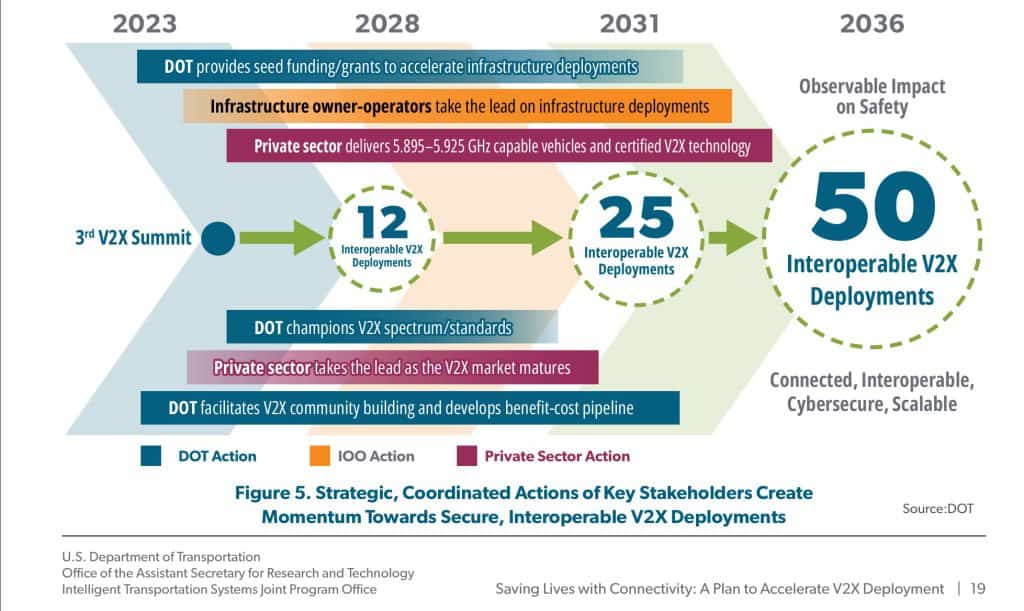
The Plan, initially released in draft form for public comment in October of last year, is focused on road safety, mobility, and efficiency through technology that enables vehicles and wireless devices to communicate with each other and with roadside infrastructure. These technologies can enable a more safe, secure, and efficient transportation system while maintaining privacy and consumer protection and will contribute to the Safe System Approach adopted by the USDOT’s National Roadway Safety Strategy, a comprehensive approach launched in January 2022 to address the crisis of roadway deaths.
“The Department has reached a key milestone today in laying out a national plan for the transportation industry that has the power to save lives and transform the way we travel,” said U.S. Secretary of Transportation Pete Buttigieg. “The Department recognizes the potential safety benefits of V2X, and this plan will move us closer to nationwide adoption of this technology.”
“The Plan was drafted and advanced with collaboration across public and private partnerships. It provides stakeholders with vital information to enable a safe, efficient, and sustainable transportation system through the national, widespread deployment of interoperable V2X technologies. The Plan will accelerate investment, research, and deployment in V2X “market certainty,” said Principal Deputy Assistant Secretary for Research and Technology and Chief Scientist Dr. Robert C. Hampshire.
“The V2X national plan was made possible through collaborative effort between government, industry and stakeholders,” said Federal Highway Administrator Shailen Bhatt. “The plan represents a call to action in providing a framework for all of us to continue to work together toward the same goal of accelerating V2X deployment to save lives on our nation’s roadways.”
Along with the National Plan, the Federal Highway Administration recently announced nearly $60 million in grants to three entities to promote the deployment of V2X technologies with the goal of advancing the full lifesaving potential of V2X communication, while ensuring that connected technologies communicate securely and without harmful interference across a variety of devices and platforms.
Arizona: The Maricopa County DOT will receive $19.6 million to lead a largescale deployment of V2X technologies, relying primarily on 5.9 GHz communications, to connect 750 physical roadside units and virtual roadside units to an estimated 400 vehicle onboard units targeting transit, emergency and freight fleets. The project will deploy Emergency Vehicle Preemption, Vulnerable Road User detection, Transit Signal Priority, and Freight Signal Priority applications in the Cities of Phoenix, Tolleson, Avondale and unincorporated Maricopa County, as well as along ADOT’s US 60.
Texas: Texas A&M Transportation Institute will receive $19.2 million to deploy V2X technology in the Greater Houston area, the City of College Station, including near the campus of Texas A&M University (TAMU), and the corridors connecting these two metropolitan cities. The project serves to holistically enhance safety, efficiency, and overall mobility for vulnerable road users (VRU) situated at signalized intersections, emergency responders navigating through varying traffic scenarios, transit operators seeking efficient routes, workers operating within construction zones, and everyday motorists.
Utah: The Utah DOT will receive $20 million toward V2X deployment sites in three states – Utah, Colorado and Wyoming – each representing a broad variety of population densities, demographics, jurisdictions, topography, and transportation facilities. The project covers all of Utah, I-80 through the entire length of Wyoming, and major portions of Colorado, including the Denver Metro Area, I-70 from Denver to the Utah border, and I-25 through Colorado. The applications focus on safety, mobility, and environment, and support the ability to demonstrate measurable impact and address critical needs including connected intersection, weather impact, curve speed warning, traveler information and vulnerable road user and other safety alert technologies.
Read Connected/Automated Vehicles and Emerging Technologies.
The DOT will develop V2X technical assistance and supporting documentation to provide deployers with a
convenient and informative resource on the technical aspects of secure, interoperable connectivity. These
materials will point to sources of more detailed technical information so that deployers can more easily
f
ind what they need to plan, develop, and operate secure, interoperable V2X deployments, as well as
engage with the supporting technical working groups to share innovations and experiences. The technical
assistance and supporting documentation will be kept up to date over time with regularly updated content
on the Smart Community Resource Center